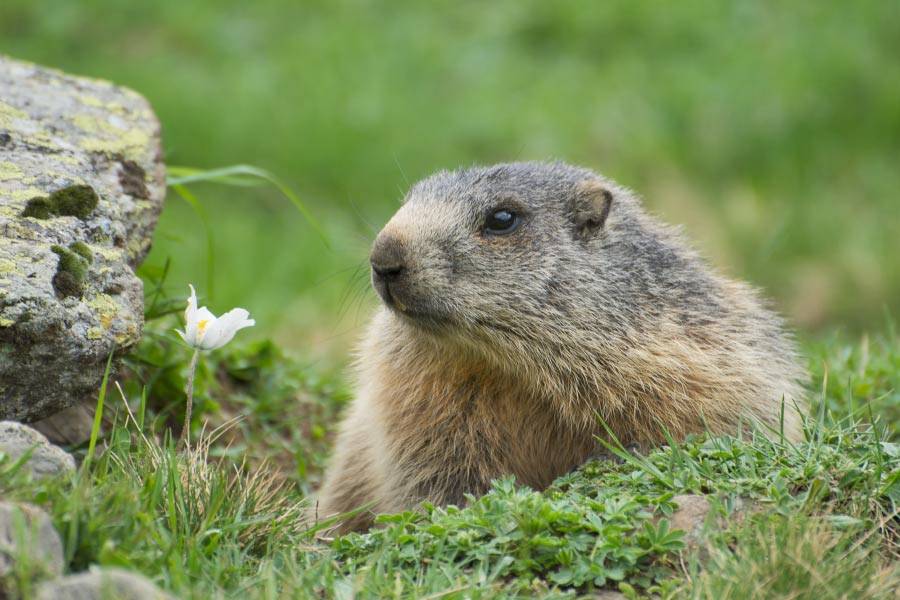
Examples of animals that hibernate include rodents such as the Alpine marmot, Arctic ground squirrel, eastern chipmunk, and groundhog; bats such as the big brown bat, gray bat and whiskered bat; and other mammals including the brown bear, black bear, and short-beaked echidna.
Non-mammalian animals that enter a state of dormancy similar to hibernation include the common box turtle, common garter snake and wood frog.
On this page, you’ll find out about the lifestyles of these and other animals that hibernate, plus interesting facts on hibernation and similar states of dormancy.
Page Index
- What Is Hibernation?
- What Types Of Animals Hibernate
- List Of Animals That Hibernate With Pictures & Facts
- Do Reptiles Hibernate?
- Do Insects Hibernate?
- Do Birds Hibernate?
- Further Reading
What Is Hibernation?
Hibernation is a natural state of prolonged inactivity and lowered metabolism that some animals undergo in order to survive periods of extreme cold, food scarcity, or other unfavorable environmental conditions.
Hibernation is an essential survival strategy that enables animals to overcome harsh conditions and maintain their energy reserves until favorable conditions return.
Hibernation typically takes place during the winter, and nearly all animals that hibernate are found in regions that experience harsh winters. (Very few animals that hibernate are found in tropical regions.)
What Types Of Animals Hibernate?
Hibernation is primarily associated with mammals such as bears, bats, and rodents.
Other types of animals, such as reptiles, birds, and insects, can exhibit a similar state of inactivity, such as brumation in reptiles and amphibians, torpor in birds, and diapause in insects, to cope with unfavorable conditions. However, while these states resemble hibernation, they differ in duration and depth of dormancy.
What Happens To An Animal’s Body When It Hibernates?
During hibernation, an animal’s body temperature, heart rate, breathing, and metabolic rate (the amount of energy it uses) significantly decrease, allowing it to conserve energy and rely on stored fat reserves.
How Long Do Animals Hibernate?
Hibernation can last for several weeks to months, depending on the species and environmental factors.
Which Animal Has The Longest Hibernation?
The Arctic ground squirrel (Urocitellus parryii) holds the record for the longest hibernation. These squirrels are native to the Arctic and sub-Arctic regions of North America, where they hibernate for up to 8-9 months, depending on the latitude and local conditions.
Estivation Vs Hibernation
Estivation (aestivation in British English) is a state of dormancy that some amphibians, reptiles and invertebrates enter to survive periods of extreme heat, drought, or food scarcity. Similar to hibernation, aestivation involves a decrease in metabolic rate, heart rate, and respiration, allowing the animal to conserve energy and minimize water loss.
However, while hibernation primarily helps animals withstand cold temperatures and harsh winter conditions, aestivation allows them to endure hot and dry environments.
List Of Animals That Hibernate
- Alpine Marmot
- Arctic Ground Squirrel
- Big Brown Bat
- American Black Bear
- Brown Bear
- Eastern Chipmunk
- European Hedgehog
- Fat-Tailed Dwarf Lemur
- Garden Dormouse
- Gray Bat
- Greater Horseshoe Bat
- Groundhog
- Hazel Dormouse
- Hoary Bat
- Northern Long-Eared Bat
- Short-Beaked Echidna
- Thirteen-Lined Ground Squirrel
- Vancouver Island Marmot
- Whiskered Bat
- Yellow-Bellied Marmot
Other Animals That Become Seasonally Inactive
- Antarctic Yellowbelly Rockcod
- Common Box Turtle
- Common Eastern Bumble Bee
- Common Garter Snake
- Common Poorwill
- Monarch Butterfly
- Texas Horned Lizard
- Wood Frog
Alpine Marmot

Scientific name: Marmota marmota
Family: Sciuridae
Where found: European Alps, Carpathian Mountains, Tatra Mountains, and Balkan Mountains
Conservation status: Least Concern
Description: Alpine marmots are large ground-dwelling squirrels, with a thickset body and short legs. They have a coarse coat that is reddish-brown to grayish-brown. These European rodents live in burrows in alpine meadows and are social animals, living in family groups.
Hibernation: Alpine marmots hibernate for about 7 months during the winter in deep burrows, with multiple individuals sharing the same burrow to conserve warmth.
Arctic Ground Squirrel
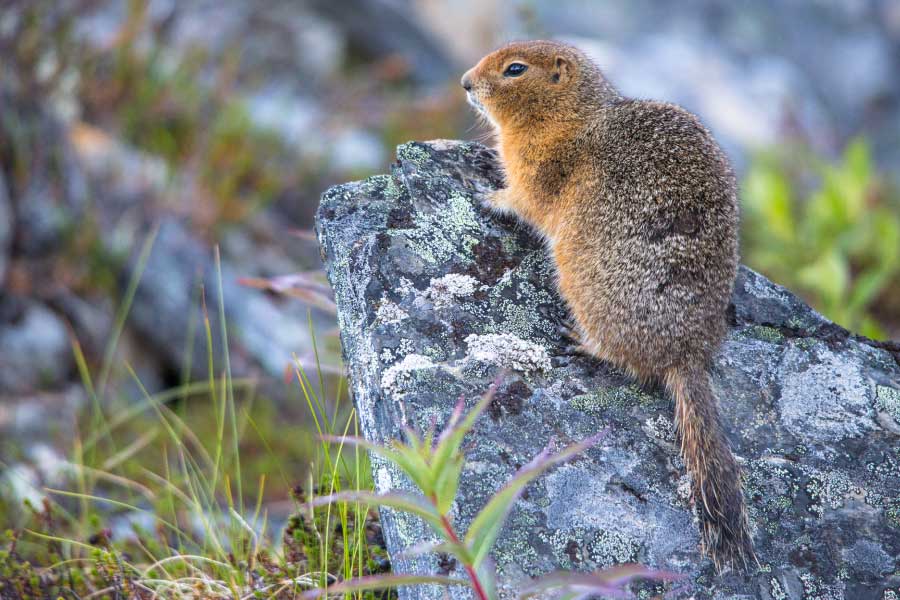
Scientific name: Urocitellus parryii
Family: Sciuridae
Where found: Northern regions of North America, particularly Alaska, Canada, and Siberia
Conservation status: Least Concern
Description: Arctic ground squirrels have a compact body with short legs and a bushy tail. They have a coat that is grayish-brown flecked with white spots. They live in burrows in tundra and boreal forest habitats.
Hibernation: Arctic ground squirrels hibernate for 7-8 months during the winter, with some having the longest and deepest hibernation of any known mammal, allowing their body temperature to drop below freezing. While hibernating, an Arctic ground squirrel’s heart beats just once per minute.
You can find out more about the Arctic ground squirrel on this page: Arctic Ground Squirrel Facts
Big Brown Bat

Scientific name: Eptesicus fuscus
Family: Vespertilionidae
Where found: North and Central America, from southern Canada to northern South America
Conservation status: Least Concern
Description: Big brown bats are medium-sized bats with a wingspan of 32-40 cm. They have a brown fur with a lighter-colored belly. They inhabit various habitats, such as forests, grasslands, and urban areas, and are insectivorous.
Hibernation: Big brown bats hibernate during the winter months in caves, mines, or buildings, forming small clusters or hibernating individually.
American Black Bear
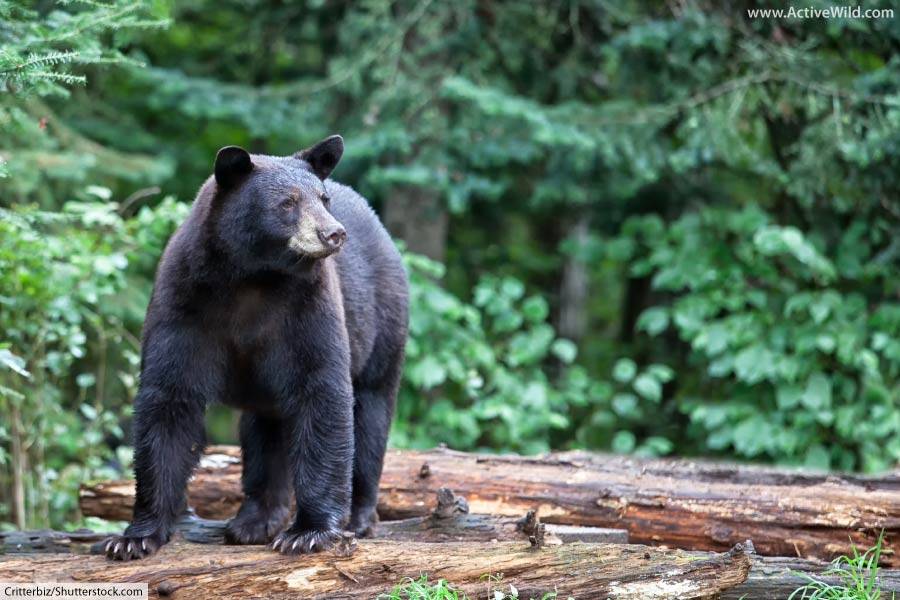
Scientific name: Ursus americanus
Family: Ursidae
Where found: North America, from Alaska to Mexico and from the Atlantic to the Pacific
Conservation status: Least Concern
Description: Black bears are medium-sized bears with a thick, black or dark brown fur. They have a broad head, a short tail, and a large body. They are omnivorous and inhabit various habitats, such as forests, swamps, and mountains.
Hibernation: Black bears hibernate during the winter months, usually for 3-7 months. They den in natural cavities, such as caves or hollow trees, or create dens by excavating soil.
You can find out more about the American black bear on this page: American Black Bear Facts
Brown Bear
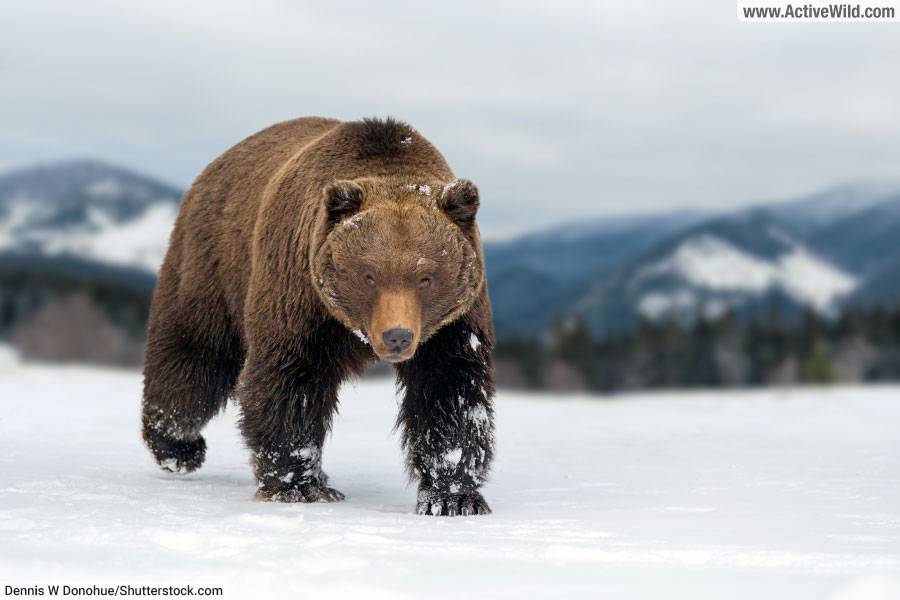
Scientific name: Ursus arctos
Family: Ursidae
Where found: North America, Europe, and Asia
Conservation status: Least Concern
Description: Brown bears are large bears with a hump on their shoulders and long, thick fur that ranges from light brown to dark brown in color. They have a large head and strong, curved claws. They are omnivorous and inhabit various habitats, such as forests, tundra, and mountains.
Brown bears found in North America are known as “grizzly bears”.
Hibernation: Brown bears hibernate during the winter months for 3-8 months, depending on the region. They den in natural cavities, such as caves or hollow trees, or create dens by excavating soil.
The polar bear, a close relative of the brown bear, does not hibernate.
You can find out more about the brown bear on this page: Brown Bear Facts
Eastern Chipmunk
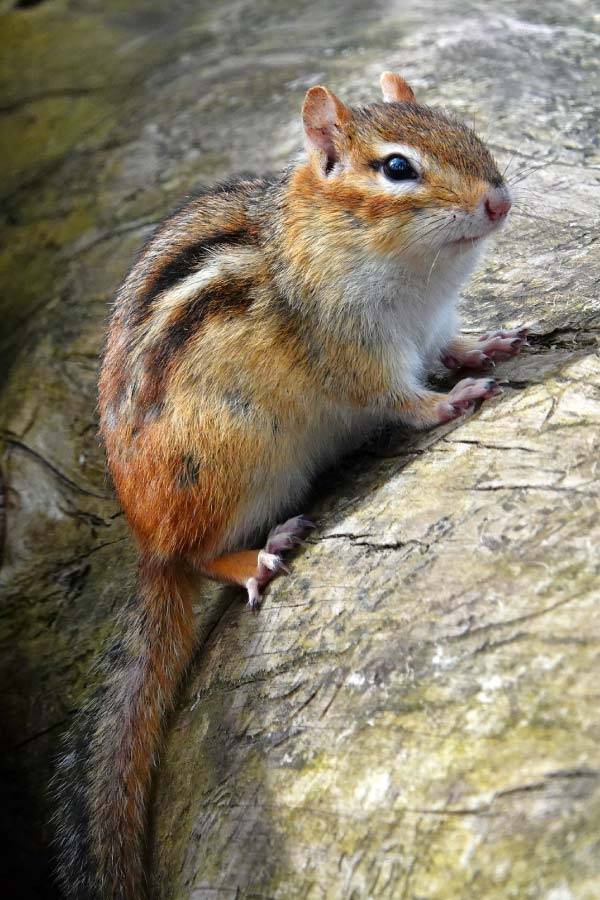
Scientific name: Tamias striatus
Family: Sciuridae
Where found: Eastern North America, from southeastern Canada to the eastern United States
Conservation status: Least Concern
Description: Eastern chipmunks are small rodents with a body length of 20-30 cm and a bushy tail. They have a reddish-brown coat with dark and light stripes on their back and head. They live in deciduous forests and feed on seeds, nuts, and insects.
Hibernation: Eastern chipmunks hibernate during the winter months, but unlike other hibernators, periodically awaken to feed food stored in their burrows.
European Hedgehog
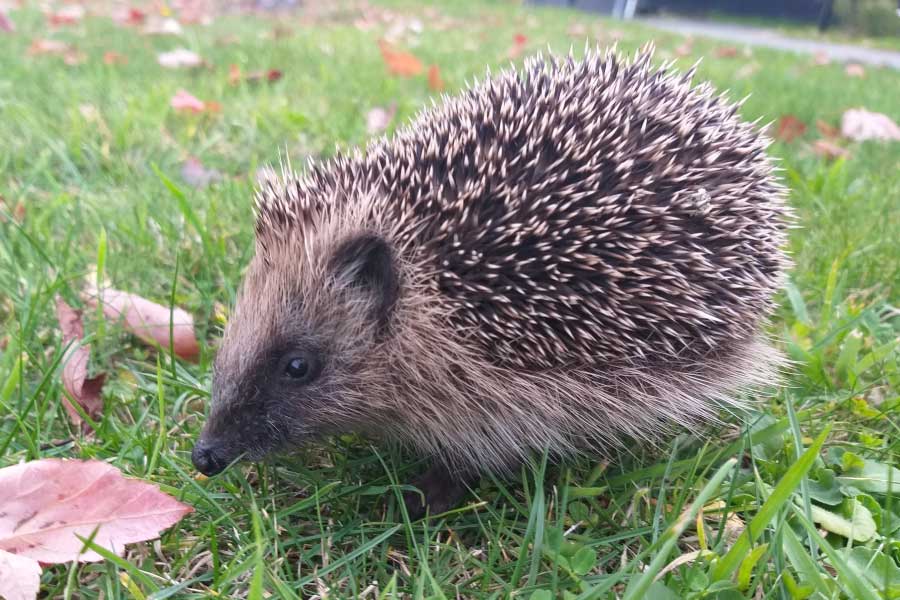
Scientific name: Erinaceus europaeus
Family: Erinaceidae
Where found: Europe, from the Iberian Peninsula to western Russia
Conservation status: Least Concern
Description: European hedgehogs are small mammals with a body length of 20-30 cm and a short tail. They have a coat of dense spines on their back and sides, with fur on their face and belly. They are nocturnal, insectivorous animals that live in a variety of habitats, such as forests, grasslands, and gardens.
Hibernation: European hedgehogs hibernate during the winter months, typically from November to March or April. They create nests of leaves and grasses in sheltered locations, such as under bushes or in piles of leaves.
You can find out more about the hedgehog on this page: Hedgehog Facts
Fat-Tailed Dwarf Lemur
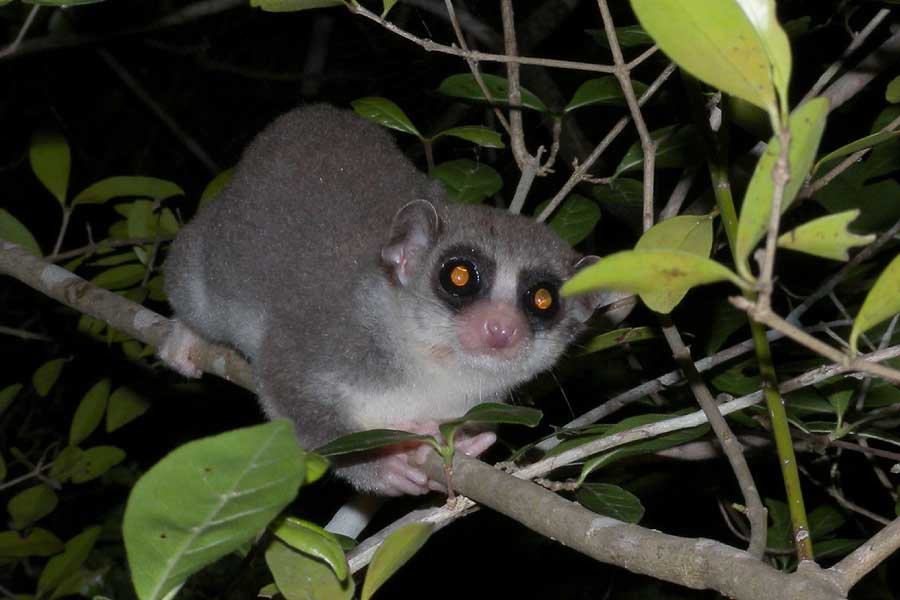
Scientific name: Cheirogaleus medius
Family: Cheirogaleidae
Where found: Madagascar
Conservation status: Vulnerable
Description: Fat-tailed dwarf lemurs are small primates with a body length of 20-28 cm and a tail that is almost equal in length. They have a gray or brown fur and large, round eyes. They are nocturnal and arboreal animals, feeding mainly on fruits and nectar.
Like all lemurs, the fat-tailed dwarf lemur is found only on the African island-country, Madagascar.
Hibernation: Fat-tailed dwarf lemurs are the only known primates to hibernate. They hibernate for up to seven months during the dry season in tree holes, relying on their stored fat in their tails as an energy source.
The Fat-tailed dwarf lemur’s hibernation may be a contributory factor to its having a significantly longer lifespan than related animals of a similar size.
Garden Dormouse
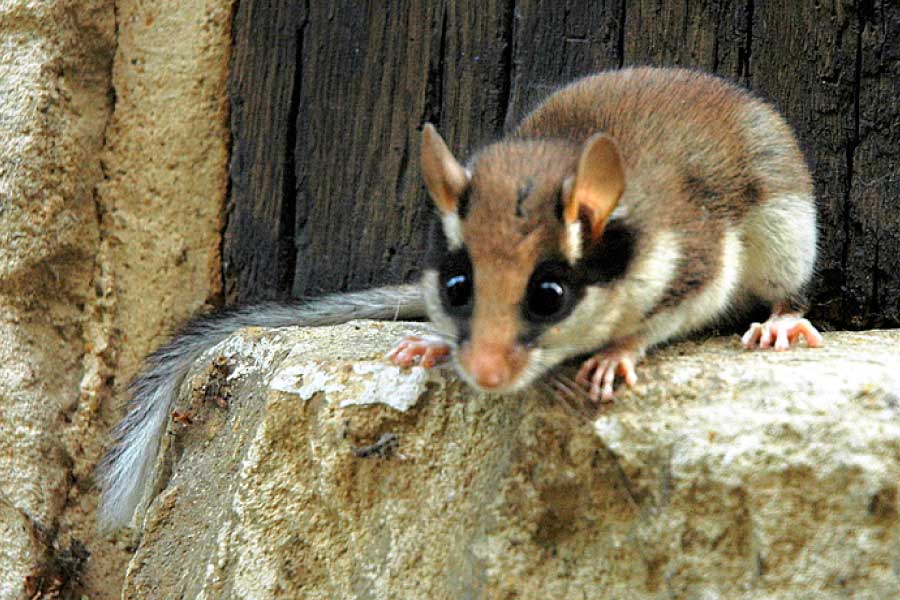
Scientific name: Eliomys quercinus
Family: Gliridae
Where found: Europe and northern Africa, from the Iberian Peninsula to the Caucasus and Morocco to Tunisia
Conservation status: Near Threatened
Description: Garden dormice are small rodents with a body length of 10-15 cm and a bushy, bicolored tail. They have a gray or brown fur with a white belly and a characteristic black mask around their eyes. They are nocturnal animals that live in various habitats, such as forests, grasslands, and gardens, feeding on insects, fruits, seeds, and small vertebrates.
Hibernation: Garden dormice hibernate during the winter months, typically from October to April. They create nests in sheltered locations, such as tree cavities, abandoned bird nests, or burrows.
Gray Bat
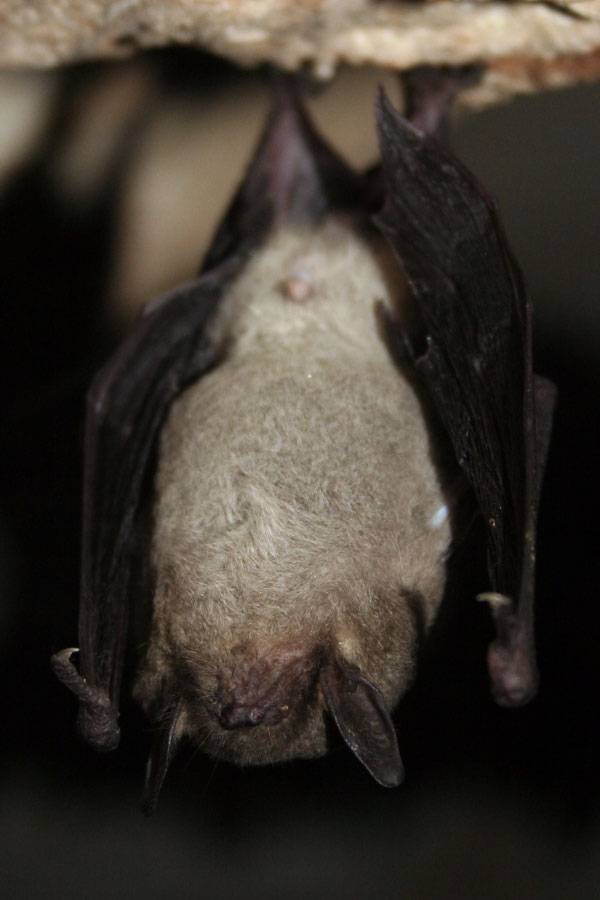
Scientific name: Myotis grisescens
Family: Vespertilionidae
Where found: Southeastern United States
Conservation status: Vulnerable
Description: Gray bats are medium-sized bats with a wingspan of 28-33 cm. As the name suggests, their fur is gray. They inhabit various habitats near water sources, such as caves, forests, and wetlands, and are insectivorous.
Hibernation: Gray bats hibernate during the winter months, typically from November to April, in caves. They form large clusters in hibernation sites, with their body temperatures dropping close to the ambient temperature to conserve energy.
Greater Horseshoe Bat
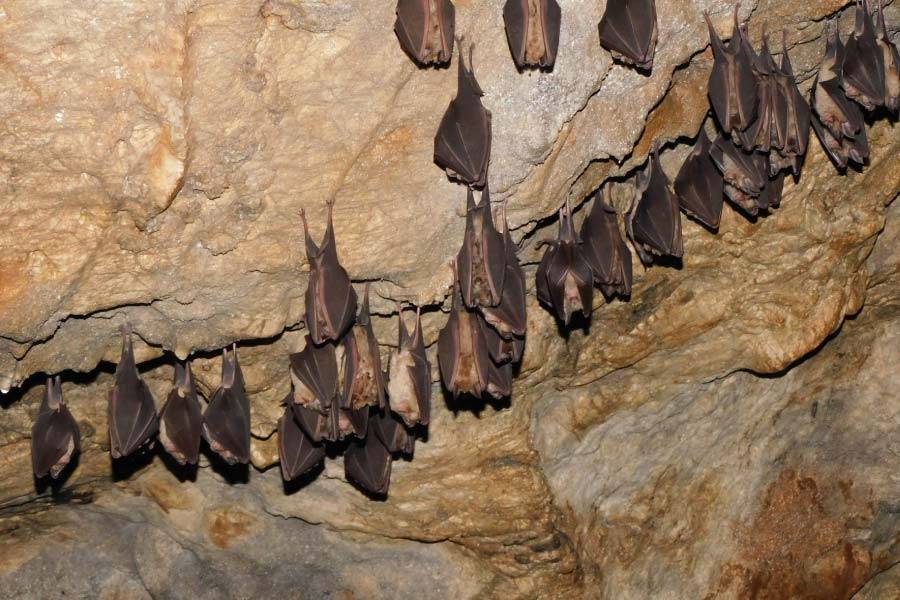
Scientific name: Rhinolophus ferrumequinum
Family: Rhinolophidae
Where found: Europe, North Africa, and parts of Asia
Conservation status: Least Concern
Description: Greater horseshoe bats are medium-sized bats with a wingspan of 34-40 cm. They have brown fur with a lighter-colored belly and a horseshoe-shaped noseleaf. They inhabit various habitats, such as forests, grasslands, and caves, and are insectivorous.
Hibernation: Greater horseshoe bats hibernate during the winter months in caves, mines, or tunnels. They hang individually or form small clusters, with their body temperature dropping to near the ambient temperature to conserve energy.
Groundhog
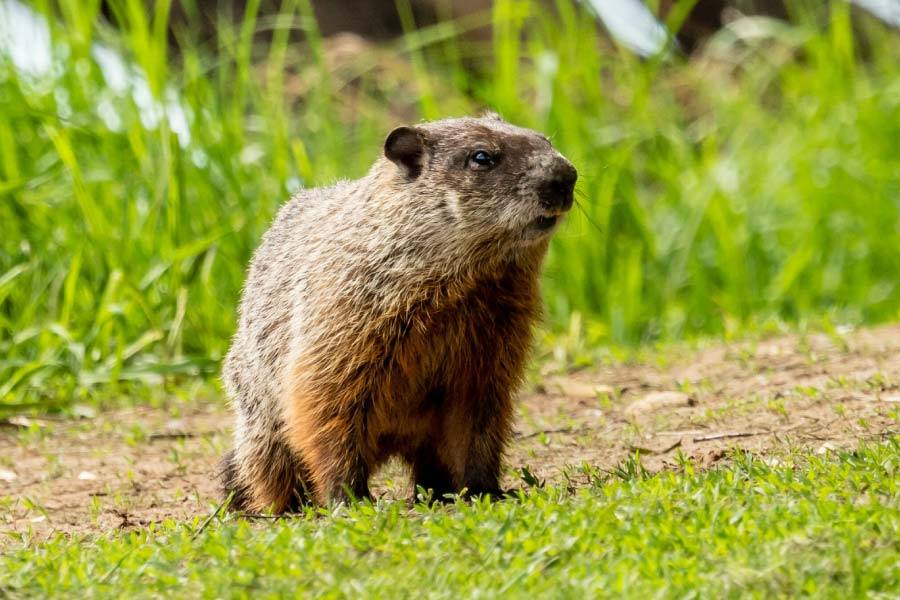
Scientific name: Marmota monax
Family: Sciuridae
Where found: North America, from Alaska to the eastern United States
Conservation status: Least Concern
No list of animals that hibernate would be complete without the groundhog, the North American rodent whose appearance in the movie Groundhog Day made it one of the world’s most famous hibernators!
Groundhogs, also known as woodchucks, are large ground-dwelling squirrels, with a thickset body and short legs. They have a coarse coat that is reddish-brown to grayish-brown in color. These large rodents live in burrows in a variety of habitats, including forests, grasslands, and suburban areas.
Hibernation: Groundhogs hibernate during the winter months, typically from October to February or March, in deep burrows. They enter a state of torpor with a significantly reduced heart rate, body temperature, and metabolic rate to conserve energy.
You can find out more about this animal on this page: Groundhog Facts
Hazel Dormouse
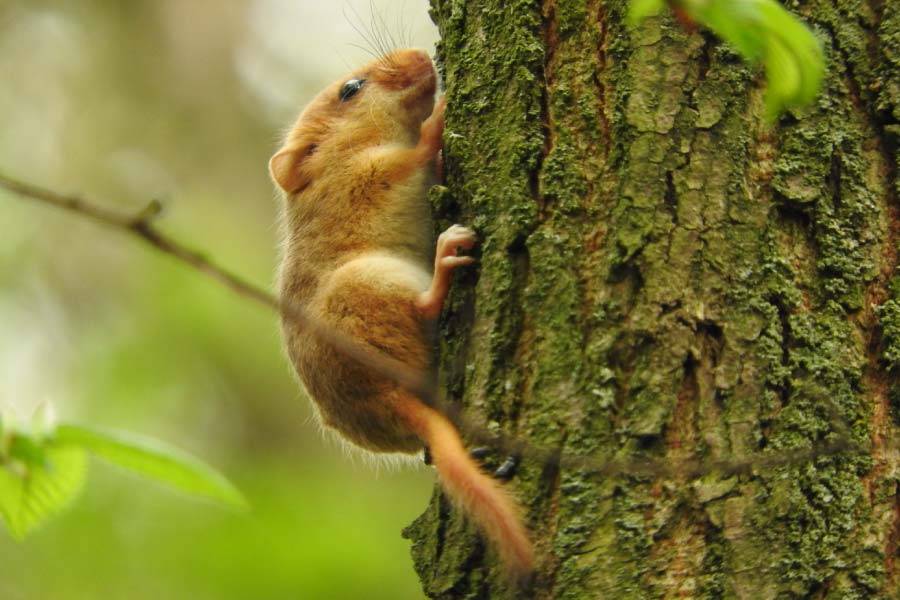
Scientific name: Muscardinus avellanarius
Family: Gliridae
Where found: Europe, from the British Isles to western Russia
Conservation status: Least Concern
Description: Hazel dormice are small rodents with a body length of 6-9 cm and a bushy tail. They have golden-brown fur with a white belly. They are arboreal (tree-dwelling), nocturnal animals that live in deciduous forests. They feed on insects, fruits, and seeds.
Hibernation: Hazel dormice hibernate during the winter months, typically from October to April, in nests located on or near the ground. They enter a state of torpor with a reduced heart rate, body temperature, and metabolic rate to conserve energy.
Hoary Bat
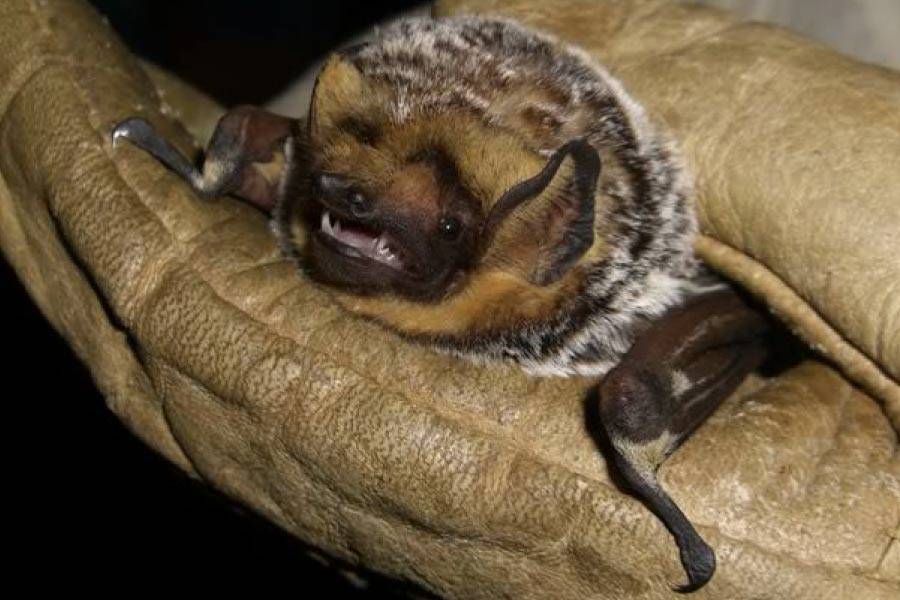
Scientific name: Lasiurus cinereus
Family: Vespertilionidae
Where found: North and South America, from Canada to Argentina
Conservation status: Least Concern
Description: Hoary bats are large bats with a wingspan of 40-43 cm. They have dense, frosty-gray fur with a lighter-colored belly. They are solitary, nocturnal animals that inhabit various habitats, such as forests and grasslands. They are insectivorous (insect-eaters).
Hibernation: Hoary bats are migratory bats that travel south to warmer climates during the winter months.
Until recently, it was thought that the species did not hibernate, instead entering a state of torpor during periods of unfavorable weather or low food availability. However, a study published in 2016 (source) demonstrates that at least some hoary bats do hibernate for up to 6 months during the winter.
Northern Long-Eared Bat
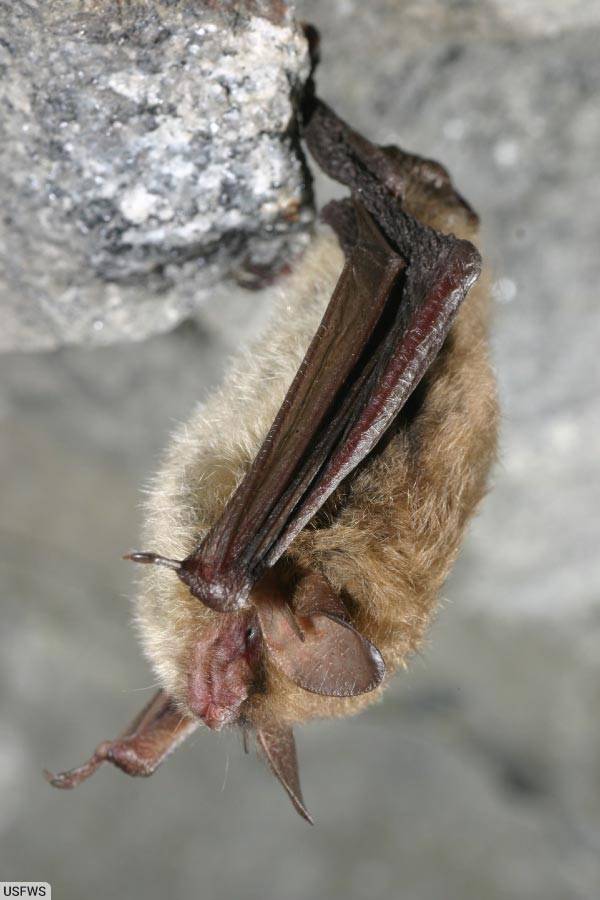
Scientific name: Myotis septentrionalis
Family: Vespertilionidae
Where found: North America, from the eastern United States to the southern parts of Canada
Conservation status: Near Threatened
Description: Northern long-eared bats are small bats with a wingspan of 23-26 cm. They have brown fur with a lighter-colored belly and characteristic long ears. They inhabit various habitats, such as forests and grasslands, and are insectivorous.
Hibernation: Northern long-eared bats hibernate during the winter months, typically from October to April, in caves, mines, or tunnels. They often choose cold, humid locations within these hibernacula, hanging individually or in small clusters.
Short-Beaked Echidna
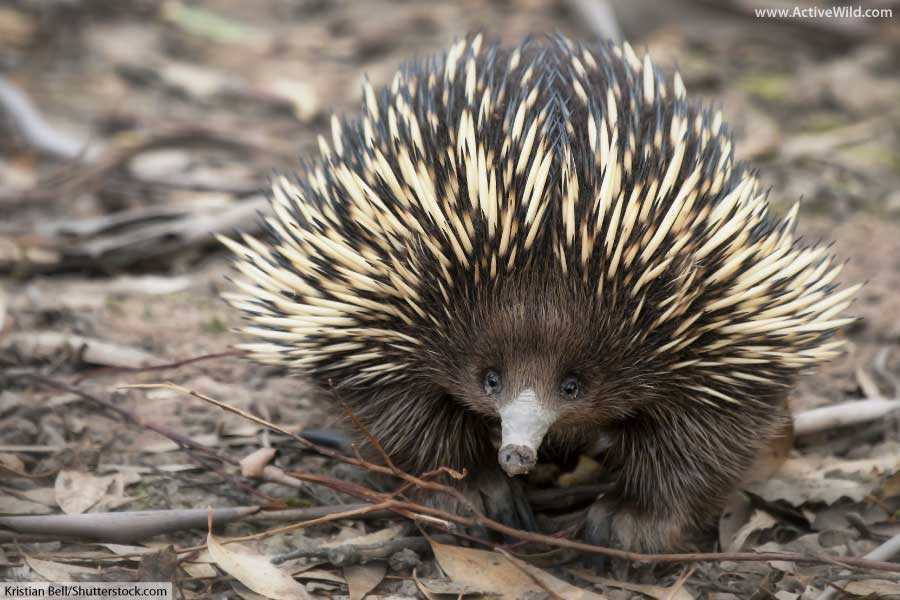
Scientific name: Tachyglossus aculeatus
Family: Tachyglossidae
Where found: Australia, including Tasmania, and parts of New Guinea
Conservation status: Least Concern
Description: Short-beaked echidnas are small, egg-laying mammals with a body length of 30-45 cm. They have a distinctive appearance with a body covered in spines and fur, a long snout, and a short tail. They are primarily insectivorous, feeding mainly on ants and termites.
Hibernation: Short-beaked echidnas hibernate during the Australian winter, retreating to their burrows between March and April, and emerging from June to August.
You can find out more about this animal on this page: Echidna Facts
Thirteen-Lined Ground Squirrel
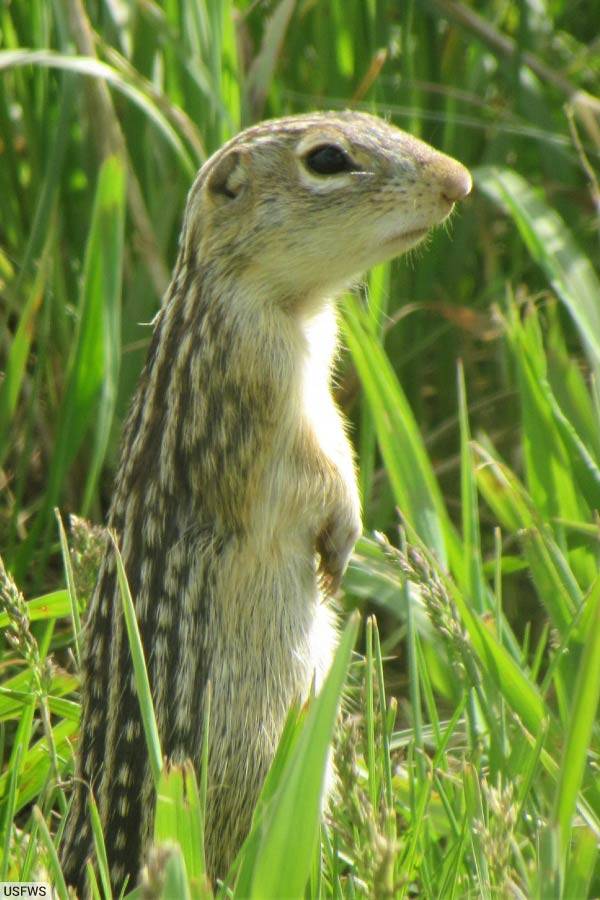
Scientific name: Ictidomys tridecemlineatus
Family: Sciuridae
Where found: North America, particularly in the Great Plains region of the United States and Canada
Conservation status: Least Concern
Description: Thirteen-lined ground squirrels are small ground-dwelling squirrels with a body length of 20-30 cm and a short tail. They have a coat that is tawny to light brown with 13 alternating dark and light stripes on their back. They live in grasslands and feed on seeds, insects, and small vertebrates.
Hibernation: Thirteen-lined ground squirrels hibernate during the winter months, typically from October to March or April, in deep burrows.
Vancouver Island Marmot
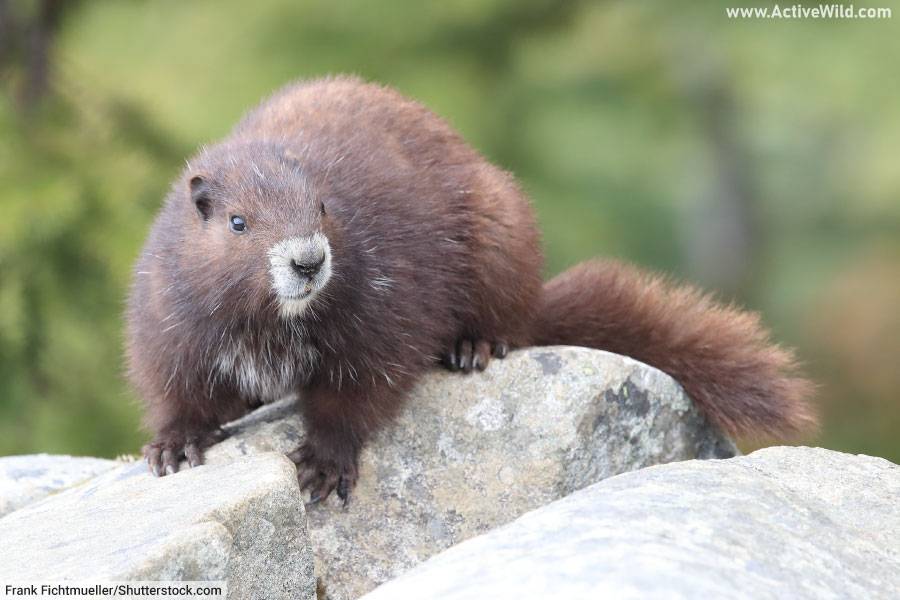
Scientific name: Marmota vancouverensis
Family: Sciuridae
Where found: Vancouver Island, British Columbia, Canada
Conservation status: Critically Endangered
Description: Vancouver Island marmots are large ground-dwelling squirrels with a thickset body and short legs. They have chocolate-brown fur with a white patch on the nose and forehead. They live in alpine meadows and subalpine forests.
Hibernation: Vancouver Island marmots hibernate for about 7 months during the winter in deep burrows, with multiple individuals sharing the same burrow in order to conserve warmth.
Whiskered Bat
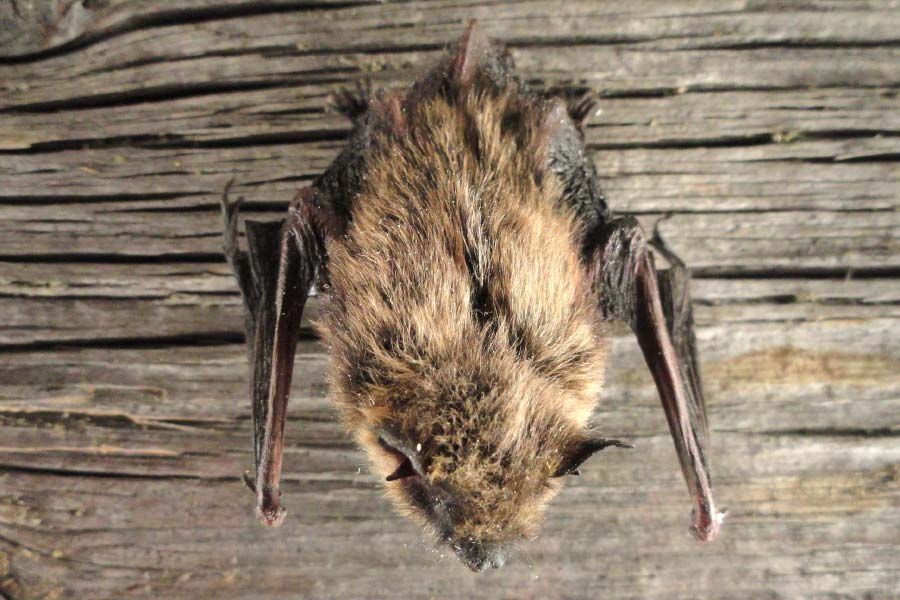
Scientific name: Myotis mystacinus
Family: Vespertilionidae
Where found: Europe and parts of Asia
Conservation status: Least Concern
Description: Whiskered bats are small bats with a wingspan of 21-25 cm. They have brown fur with a lighter-colored belly and a distinctive fringe of hairs around the snout. They inhabit various habitats near water sources, such as forests, grasslands, and wetlands, and are insectivorous.
Hibernation: Whiskered bats hibernate during the winter months, typically from October to April, in caves, mines, or tunnels. They hang individually or form small clusters.
Yellow-Bellied Marmot
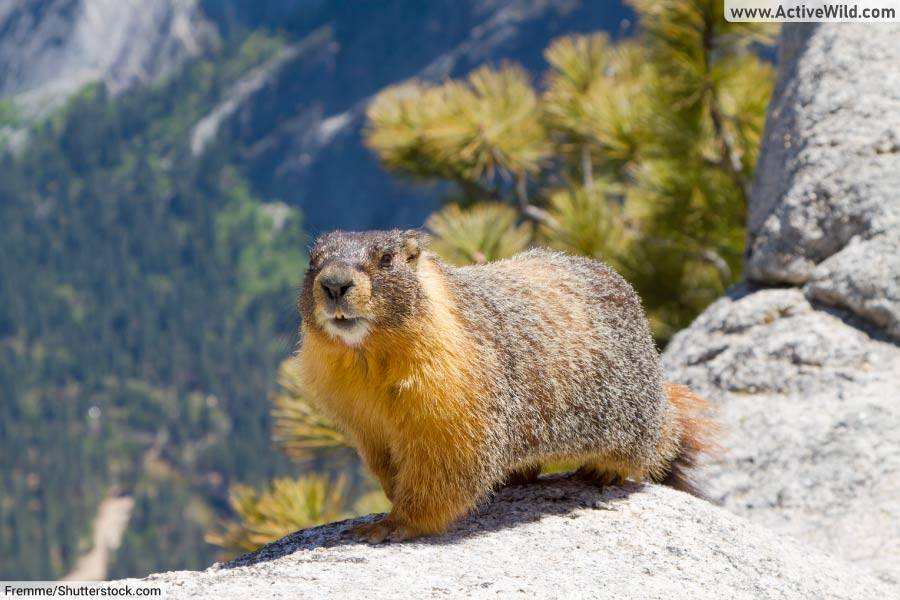
Scientific name: Marmota flaviventris
Family: Sciuridae
Where found: Western North America, from southwestern Canada to the western United States
Conservation status: Least Concern
Description: Yellow-bellied marmots are large ground-dwelling squirrels with a thickset body and short legs. They have a coat that is brown to reddish-brown with a yellowish belly. They live in rocky habitats, such as mountains and grasslands, and feed on grasses, flowers, and seeds.
Hibernation: Yellow-bellied marmots hibernate during the winter months, typically from September to April or May, in deep burrows.
Other Animals That Become Seasonally Inactive
Although hibernation is found only in mammals, many other animals exhibit comparable extended periods of inactivity as a means on conserving energy during the colder months. Below are some examples of animals other than mammals that seasonally “hibernate”.
Antarctic Yellowbelly Rockcod
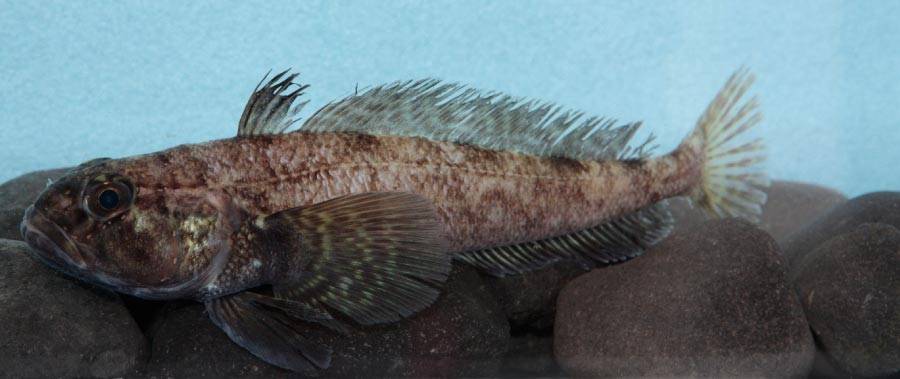
Scientific name: Notothenia coriiceps
Family: Nototheniidae
Where found: Southern Ocean, particularly around the Antarctic Peninsula and subantarctic islands
Conservation status: Not Evaluated
Description: Antarctic yellowbelly rockcod, also known as black rockcod, are fish with a body length of up to 60 cm. They have a dark brown to olive-green coloration with a yellowish belly. They inhabit rocky areas and feed on invertebrates and other fish.
Hibernation: Although not true hibernators, Antarctic yellowbelly rockcod are unusual among fish as they do lower their metabolism during the winter, entering a state of dormancy comparable to hibernation in mammals. (source)
Common Box Turtle
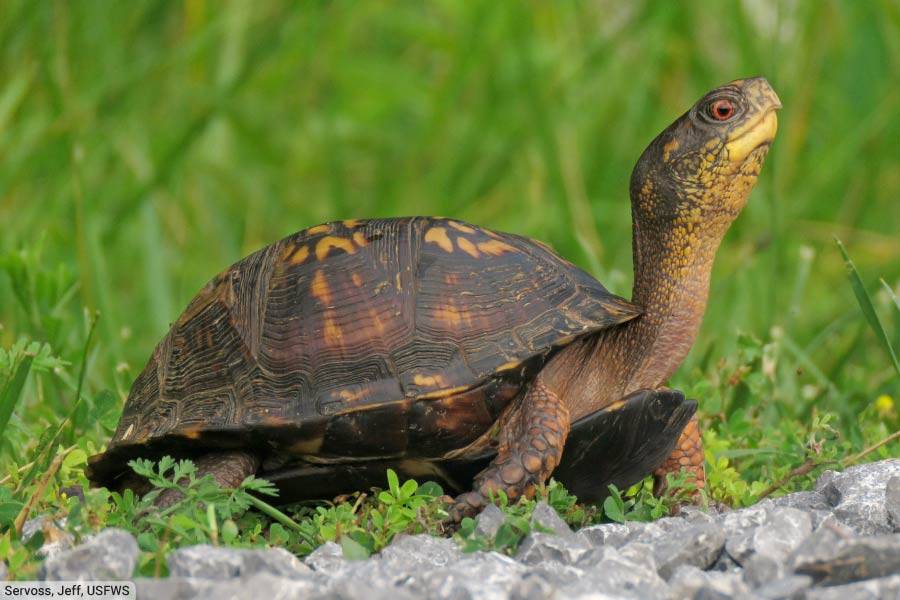
Scientific name: Terrapene carolina
Family: Emydidae
Where found: Eastern United States
Conservation status: Vulnerable
Description: Common box turtles are small, terrestrial turtles with a high-domed carapace that is brown to black with yellow or orange markings. They have a hinged plastron, allowing them to close their shell completely. They inhabit various habitats, such as forests, grasslands, and wetlands, and feed on a variety of plants and animals.
Hibernation: Common box turtles, like several other species of turtle, enter a state of brumation during the winter months. The common box turtle’s brumation takes place from October to March, in burrows or under leaf litter.
Common Eastern Bumble Bee
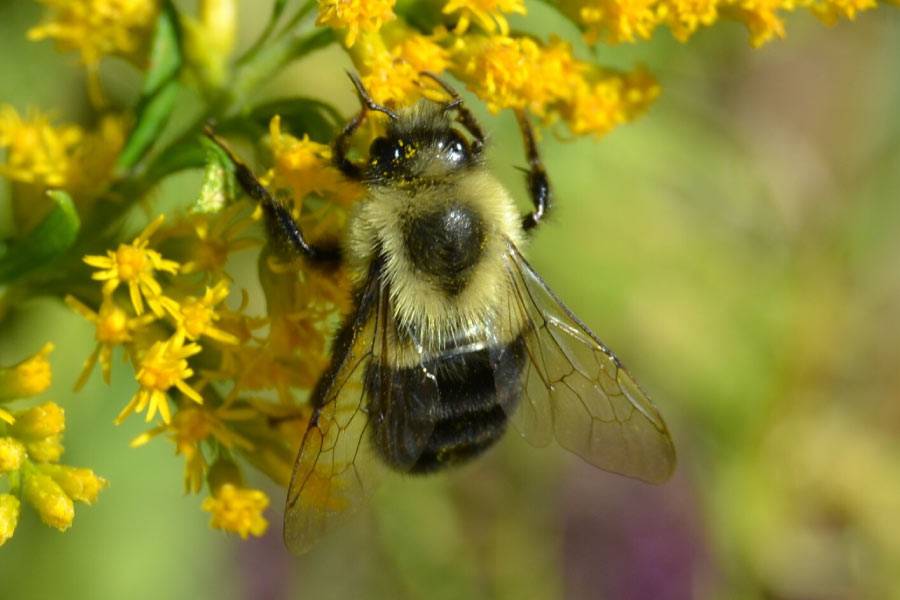
Scientific name: Bombus impatiens
Family: Apidae
Where found: Eastern North America
Conservation status: Least Concern
Description: The most common bumblebees in the Eastern United States, common eastern bumblebees have a black body with a yellow band on the thorax and first abdominal segment, and are between 8-17 mm in length. They inhabit various habitats, such as forests, grasslands, and gardens, and feed on nectar and pollen from flowers.
Hibernation: As with most bumblebees, only the fertilized queen bumblebee overwinters, typically in a small burrow or under leaf litter. Here, the queen bee enters a state of torpor with a reduced metabolic rate to conserve energy. The rest of the colony, including workers and males, dies off in the fall.
Common Garter Snake
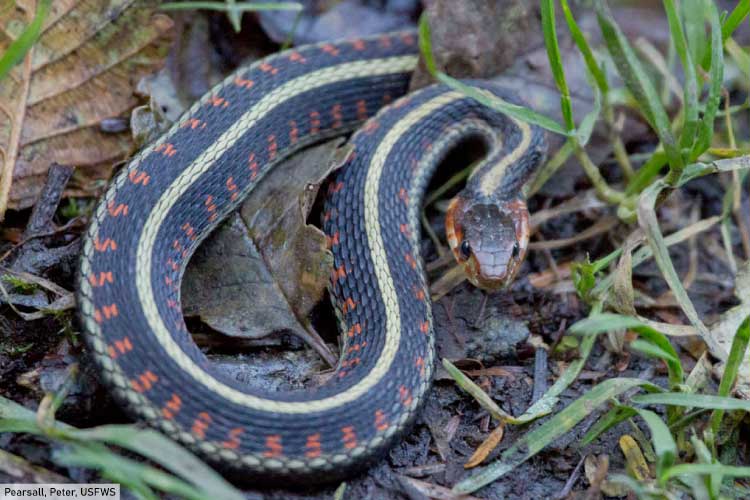
Scientific name: Thamnophis sirtalis
Family: Colubridae
Where found: North America, from Alaska to Central America
Conservation status: Least Concern
Description: Common garter snakes are small to medium-sized snakes with a body length of 46-137 cm. They have a dark body with three longitudinal stripes that can be yellow, blue, or white. They inhabit various habitats, such as forests, grasslands, and wetlands, and feed on a variety of prey, including amphibians, fish, and invertebrates.
Hibernation: The common garter snake enters a state of brumation during the winter months, typically from October to March, in communal dens or burrows. During this time, the snake’s metabolic rate and body temperature both decrease.
Common Poorwill
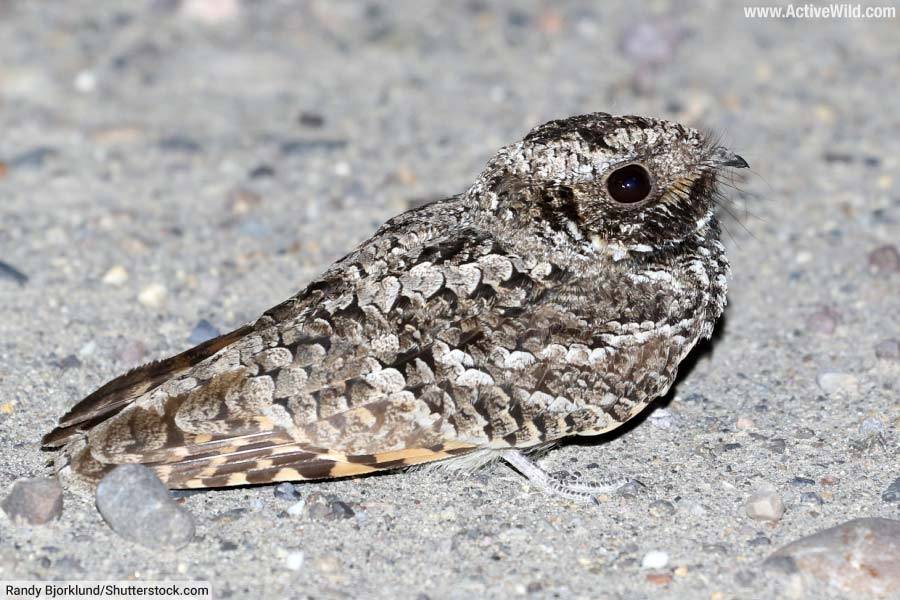
Scientific name: Phalaenoptilus nuttallii
Family: Caprimulgidae
Where found: Western North America
Conservation status: Least Concern
Description: Common poorwills are small, nocturnal birds with a body length of 19-21 cm. They have a mottled gray and brown plumage, which provides excellent camouflage. They inhabit arid and semi-arid habitats, such as deserts, shrublands, and grasslands, and feed on insects.
Hibernation: The common poorwill is unique among birds as it enters a state of extended torpor similar to hibernation during the winter. During torpor, which can last for several months, the bird’s metabolic rate, heart rate, and body temperature decrease significantly.
Monarch Butterfly
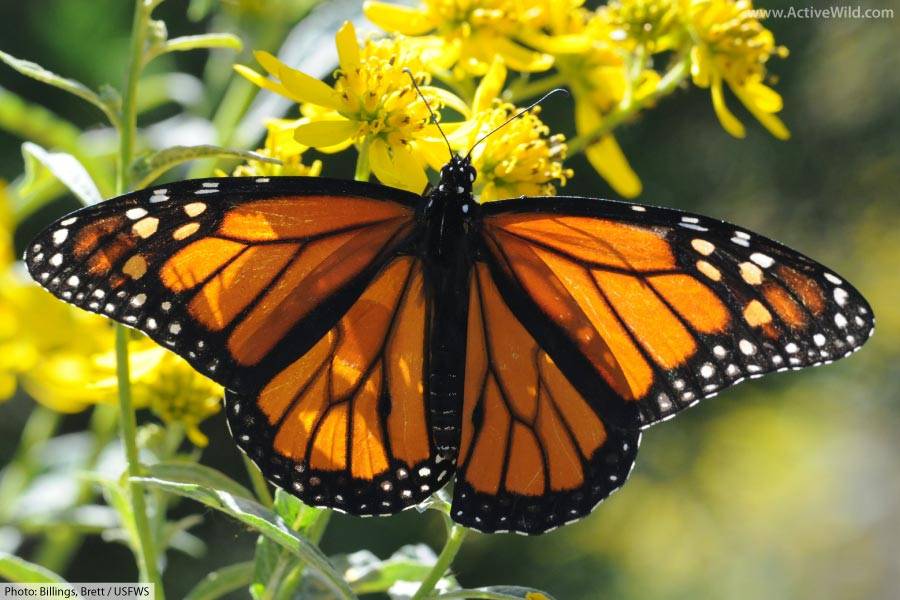
Scientific name: Danaus plexippus
Family: Nymphalidae
Where found: North, Central, and South America
Conservation status: Least Concern
Description: Monarch butterflies are large, brightly colored butterflies with a wingspan of 8.5-12.5 cm. They have an orange and black pattern on their wings with white spots along the edges. They inhabit various habitats, such as forests, grasslands, and gardens, and feed on the nectar of flowers.
Hibernation: Monarch butterflies are migratory insects, with eastern North American populations traveling to central Mexico during the winter months. They do not hibernate but do overwinter in a state of reproductive diapause, in which their reproductive development is paused. During this time, the butterfly is largely inactive, resting – often in large numbers – in trees.
You can find out more about this animal on this page: Monarch Butterfly Facts
Texas Horned Lizard
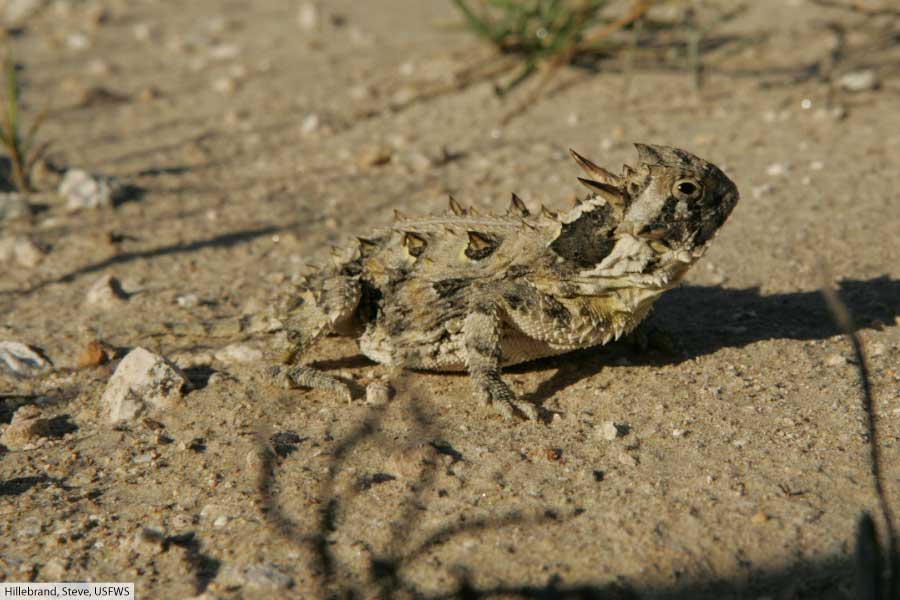
Scientific name: Phrynosoma cornutum
Family: Phrynosomatidae
Where found: South-central United States and northern Mexico
Conservation status: Least Concern
Description: Texas horned lizards are small, flattened lizards with a body length of 6.5-10 cm. They have a brown or gray body with numerous spines and two large horns on their head. They inhabit arid and semi-arid habitats, such as deserts, grasslands, and scrublands, and feed primarily on ants.
Hibernation: Texas horned lizards enter a state of brumation during the winter months, typically from November to February, in burrows or under rocks. During this time, the lizard’s metabolic rate and body temperature decrease in order to conserve energy.
Wood Frog
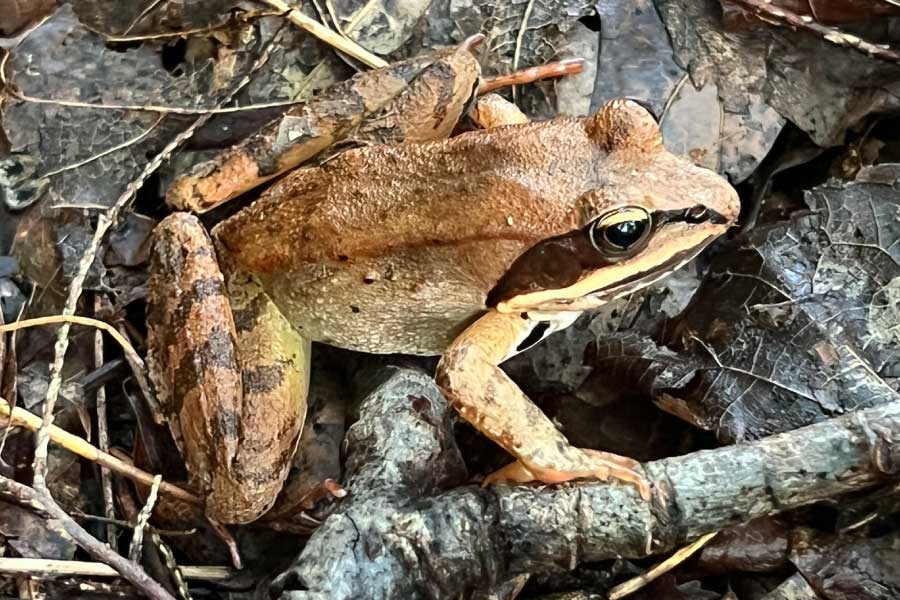
Scientific name: Lithobates sylvaticus
Family: Ranidae
Where found: North America, from the northeastern United States to Alaska and northern Canada
Conservation status: Least Concern
Description: Wood frogs are small to medium-sized frogs with a body length of 3.5-7.5 cm. They have brown or reddish-brown skin with a dark, mask-like marking around their eyes. They inhabit various habitats, such as forests, grasslands, and wetlands, and feed on a variety of insects and other invertebrates.
Hibernation: Wood frogs enter a state of hibernation during the winter months, typically from October to March, under leaf litter or in shallow burrows. They can tolerate freezing of their body fluids, which allows them to survive in extremely cold temperatures. Their metabolic rate decreases significantly to conserve energy during hibernation.
Do Reptiles Hibernate?
Reptiles, being ectothermic (cold-blooded animals), rely on external heat sources to regulate body temperature. As a result, during cold seasons or when environmental temperatures drop, they may enter a state called brumation, which is similar to hibernation.
Unlike true hibernation, which is more common among mammals, reptiles in brumation may still be somewhat active, occasionally basking to warm up or even drinking water.
The duration and intensity of brumation varies between reptile species and specific environmental conditions. So, while reptiles do not technically hibernate, they do exhibit a similar form of dormancy known as brumation to help them survive colder conditions.
You can find out more about reptiles on this page: Reptiles – The Ultimate Guide
Do Insects Hibernate?
Insects, as cold-blooded creatures, are significantly affected by changes in temperature. To survive cold weather or unfavorable environmental conditions, many insects enter a state known as diapause, which is similar to hibernation.
Diapause is a period of dormancy characterized by reduced metabolic activity, halted growth, and a lowered need for food and water. During diapause, insects often seek shelter in protected spaces, such as under tree bark, in leaf litter, or even inside human-made structures.
Different insect species have varying responses to environmental cues, which may trigger diapause at different life stages, such as eggs, larvae, pupae, or adults.
You can find out more about insects on this page: Insects – The Ultimate Guide
Do Birds Hibernate?
Birds, like mammals, are warm-blooded animals. However, they do not hibernate in the traditional sense. Being able to fly is a major advantage during hard times, and the main strategy adopted by birds for coping with cold temperatures and reduced food availability during winter months is migration.
Some bird species are known to enter a state called torpor, which is a short-term, reversible hibernation-like state. During torpor, birds significantly reduce their metabolic rate, body temperature, and other physiological processes to conserve energy. However, the common poorwill (mentioned in the list of animals that hibernate above) is the only bird known to enter torpor for an extended period of time.
You can find out more about birds on this page: Birds – The Ultimate Guide
Further Reading
The post Animals That Hibernate: Pictures & Facts – What Animals Hibernate? appeared first on Active Wild.